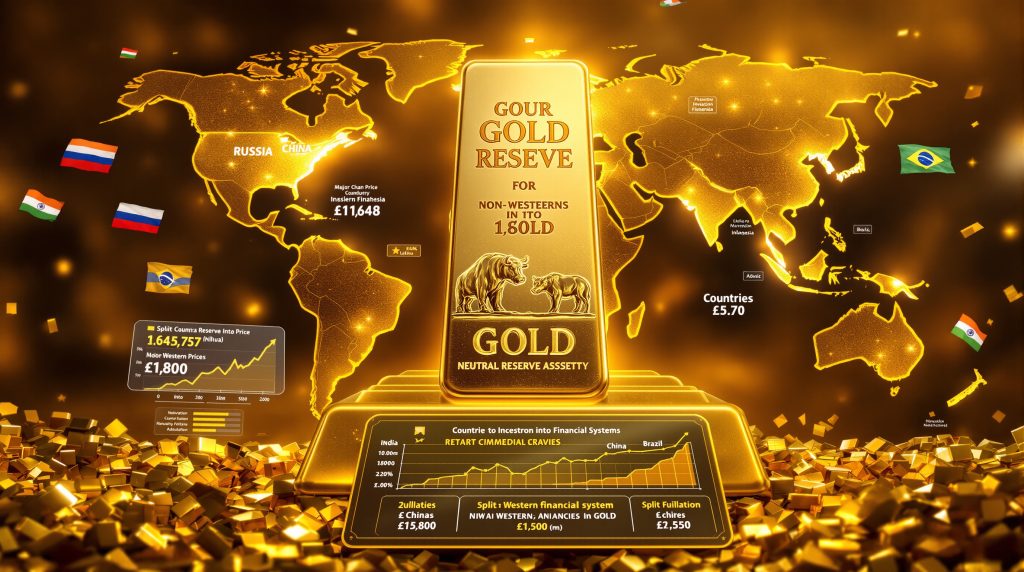What is Driving Gold's Role as a Neutral Reserve Asset in the Global Economy?
Gold's stature as a neutral reserve asset has never been more significant, as global economic tremors and political uncertainty drive nations to reevaluate their financial strategies. Central banks are shifting their portfolios, and investors seek stability as the prevailing financial order is challenged by new alliances, emerging technologies, and the weaponization of traditional financial infrastructure. The following analysis examines the underlying forces behind gold's rising centrality and explores unique insights uncovered from experts in finance and geopolitics.
How Has Gold's Price Movement Signaled Shifts in Global Finance?
Gold has seen a remarkable surge in value in recent years, with prices reaching historical highs in 2024. While some reporting has suggested peaks over $3,700 per ounce, major exchanges such as COMEX and LBMA indicate verified spot prices have approached (but not exceeded) the $2,400–$2,500 per ounce range in mid-2024. This climb is largely attributed to intensified geopolitical risk, persistent inflation concerns, and an evolving global monetary system.
Notably, gold has been among the best-performing assets of 2024, outstripping major equity indices and acting as a barometer for diminishing confidence in traditional Western financial instruments. As the U.S. Federal Reserve signaled softer monetary policies and global tensions remained high, gold's role has grown as both a hedge against currency risk and as an indicator of systemic uncertainty.
Recent Gold Price Milestones (USD/oz)
| Date | Price | Context |
|---|---|---|
| Q1 2024 | ~$2,350–2,400 | Geopolitical tensions, inflation, central bank demand |
| Q2 2024 | ~$2,375 | Fed hints at policy shifts, robust central bank buying |
| Q3 2024 | ~$2,450+ | Global uncertainty, further non-Western accumulation |
Financial experts interpret gold's surge as an inverse measure of U.S. dollar influence. As the dollar's relative safety and neutrality are questioned, more capital flows into gold—positioning it as the centerpiece of a shifting global reserve paradigm. Recent gold price analysis confirms this trend is likely to continue through 2025.
Why Are Central Banks Moving Away from U.S. Treasuries Toward Gold?
For decades, U.S. Treasuries functioned as the principal neutral reserve asset for global trade surpluses. This allowed the U.S. to run significant deficits at low interest rates while providing liquidity and perceived stability to international markets. However, several key developments are eroding this foundation:
- Post-2008 U.S. monetary expansion raised concerns about dollar stability and long-term inflation risks, especially in China and among emerging economies.
- The increasing use of dollar-denominated assets as tools for sanctions and geopolitical leverage. Over $300 billion in Russian assets were frozen after the 2022 Ukraine conflict, undermining the perception of Treasuries as politically neutral (U.S. Treasury, 2022).
- Central banks—especially in nations facing sanction risk—have accelerated gold purchases to insulate themselves from potential asset seizures or devaluations. In 2022, central bank gold purchases hit a 55-year high with global reserves topping 1,136 tonnes (World Gold Council, 2023).
When a reserve asset's value can be determined or threatened by a single state's policy, its neutrality is fatally compromised. Gold, which is not a liability of any nation, offers protection from such interventions.
Central banks increasingly view gold as the only asset that remains free from the political, financial, or policy risks tied to sovereign issuers.
How Is the International Order Reshaping the Function of Reserve Assets?
The emergence of new alliances—exemplified by the close economic and strategic cooperation between China, Russia, India, Brazil, and Indonesia—has accelerated a bifurcated global currency landscape. These nations are now conducting increased trade outside Western-centric finance channels, bypassing the U.S. dollar and Euro, and favoring alternative payment rails, including gold settlements.
During recent Shanghai Cooperation Organization meetings, major developing economies announced frameworks for a new development bank to support the Global South. This initiative echoes a larger push for alternatives to Western-dominated financial systems, paralleling the rise of non-SWIFT payment platforms and gold-backed trade settlements.
Such developments signal both a reimagining of international monetary arrangements and a deliberate move toward multipolar reserve strategies. The historic price surge in gold markets reflects this fundamental shift in global financial architecture.
Why Is Gold Regarded As "Neutral" Compared to Fiat Currencies?
Gold's reputation for neutrality stems from several unique attributes:
- It is not issued by, nor a liability of, any government, central bank, or institution.
- It requires no trust in an external party's creditworthiness.
- Gold's supply is inherently limited by geological realities, with annual new production averaging approximately 4,700–5,000 tonnes (World Gold Council, 2023).
Faith in U.S. and European sovereign debt has been eroded by political intervention, monetary expansion, and the regular threat of sanctions. In contrast, gold continues to serve as a universally accepted store of value and means of settlement, transcending geopolitics.
Unlike Treasuries or other government bonds, gold cannot be defaulted upon, seized by unilateral legal action, or directly manipulated by domestic policy decisions.
What Are the Geopolitical Drivers for Embracing Gold as a Reserve?
How Has the US Dollar's Weaponization Influenced Global Reserve Strategy?
A crucial inflection point has been the overt use of dollar-based financial infrastructure as a tool of statecraft. High-profile cases include:
- Russia's systematic reduction of U.S. Treasury holdings since 2014, paired with record growth in its gold reserves and alternative settlement mechanisms.
- China's creation of a major physical gold exchange to underpin regional monetary strategies and reduce reliance on Western intermediaries.
Unilateral sanctions and exclusion from SWIFT have motivated at-risk nations to seek immunity from future asset freezes by diversifying into gold and regional currencies.
How Are Nations Coordinating to Challenge Dollar Dominance?
Recent international summits have provided platforms for non-Western powers to formalize gold-based or gold-indexed settlement arrangements. The creation of development banks independent from Bretton Woods institutions, and new interbank payment rails, highlight a shared recognition among BRICS and the Global South of the need for alternatives.
Central banks increasingly perceive physical gold as a critical shield against unpredictable policy moves by Washington and its allies—a clear divergence from prior norms.
What Role Do Military and Security Considerations Play in Reserve Allocation?
Displays of military power, such as China's advanced weapons parade and the increasing cooperation between Russia, China, North Korea, and Iran, act as signals of a rebalanced global power dynamic. Nations at odds with the West see greater risk in holding Western assets, prompting acceleration in gold accumulation to offset the potential repercussions of renewed conflict, sanctions, or sudden diplomatic rifts.
How Does Gold Provide Economic and Financial Security?
What Makes Gold Unique as a Strategic Reserve?
Several features distinguish gold as a strategic reserve asset:
- Tangibility: Gold is a physical asset, immune to digital manipulation, cyberattacks, or default by fiat.
- Universal acceptability: Gold retains value globally and can serve as collateral or direct settlement in a crisis.
- No counterparty risk: Physical gold requires no trust in foreign institutions or adherence to foreign legal regimes.
During periods of geopolitical tension or sanctions threats, these factors make gold vital as a safe haven for both state and private actors. Furthermore, developing proper investment strategies around gold has become crucial for institutional investors seeking to navigate this evolving landscape.
How Could Revaluation of Gold Impact National Balance Sheets?
A dramatic rise in gold prices could provide fiscal relief to highly indebted nations. Governments could recognize the market value of their gold reserves, shoring up balance sheets without direct borrowing. For example:
| Country | Gold Reserves (tonnes) | Book Value (USD/oz) | Revalued Value at $2,450/oz* |
|---|---|---|---|
| US | 8,133.5 | $42.22 | ~$640 Billion |
| China | 2,191.5 | $42.22 | ~$172 Billion |
| *Approximate values, using public data and prevailing market prices. |
Revaluation could serve as a financial buffer, though it is not a substitute for structural reforms or fiscal discipline. (Disclaimer: Theoretical values for illustration; actual revaluations carry complex risks and are subject to political and market uncertainties.)
What Content Gaps Exist in Current Analyses of Gold's Role?
What Are the Long-Term Implications of a Bifurcated Financial System?
The world appears poised to settle into two currency spheres:
- Advanced economies maintaining the U.S. dollar's dominance
- Global South powers increasingly relying on gold as a neutral reserve asset and regional settlement currencies
This split introduces higher volatility in exchange rates, complicates international trade, and could diminish the U.S.'s ability to finance persistent deficits at minimal cost.
How Will Stablecoin Regulation and Digital Finance Influence Reserve Flows?
Recent U.S. regulations now require stablecoin providers to back tokens with short-term U.S. Treasuries. If the stablecoin market grows to $5–7 trillion in capitalization, a sizable, consistent bid for Treasuries could support U.S. government financing. However, this mechanism hinges on global adoption and trust in the dollar system.
Non-Western countries are simultaneously developing digital settlement systems independent of the dollar—for example, cross-border central bank digital currencies (CBDCs) and local-currency trade agreements. This dynamic may fragment global reserve flows further, increasingly reflecting the polarity of the new economic order. Current gold price forecast models suggest this fragmentation will likely accelerate gold's appreciation through 2025.
FAQ: Gold as a Neutral Reserve Asset
What distinguishes a "neutral reserve asset"?
A neutral reserve asset is universally accepted, not tied to the policy or political risk of any single country, and retains value regardless of shifting alliances or sanctions.
Which countries are leading the shift toward gold as a reserve?
Russia, China, India, Brazil, Indonesia, and other Global South economies have sharply increased their gold reserves, seeking to insulate themselves from potential sanctions and de-dollarize cross-border transactions.
Could gold fully replace fiat reserves in global trade?
It is unlikely that gold will supplant reserve currencies entirely, but its role as a strategic backstop in multi-lateral and extra-sovereign transactions is expanding rapidly.
How does gold perform during periods of geopolitical instability?
Historical data shows that gold tends to appreciate during global crises or when confidence in major fiat currencies erodes—reflecting both risk aversion and the search for enduring value. This pattern has contributed to record high prices in recent years.
Conclusion: Is Gold Set to Become the Foundation of a New Financial Order?
Gold's enduring qualities—tangibility, neutrality, and universal acceptability—uniquely position it as the asset of choice for nations, investors, and institutions seeking shelter from economic and geopolitical upheaval. The strong movement of central banks toward gold, the visible fractures in the fiat-based order, and the proliferation of alternative payment and settlement systems all suggest that gold as a neutral reserve asset is poised to play an even greater role in underpinning the new economic architecture.
Disclaimer: The above analysis is for informational purposes only and does not constitute financial or investment advice. Actual outcomes depend on future policy actions and unpredictable global events.
Further Exploration:
Readers interested in in-depth analysis and expert commentary on gold's evolving global role can explore discussions from thought leaders featured in Sprott's insights on gold's role as an alternative reserve asset and LSEG's analysis of gold's strategic revival.
Want to Profit from the Next Major Gold Discovery?
Discovery Alert's proprietary Discovery IQ model delivers real-time notifications when significant mineral discoveries are announced on the ASX, including potentially transformative gold finds. Explore why major mineral discoveries can lead to substantial returns by visiting the Discovery Alert discoveries page and position yourself to capitalise on the next gold opportunity.




